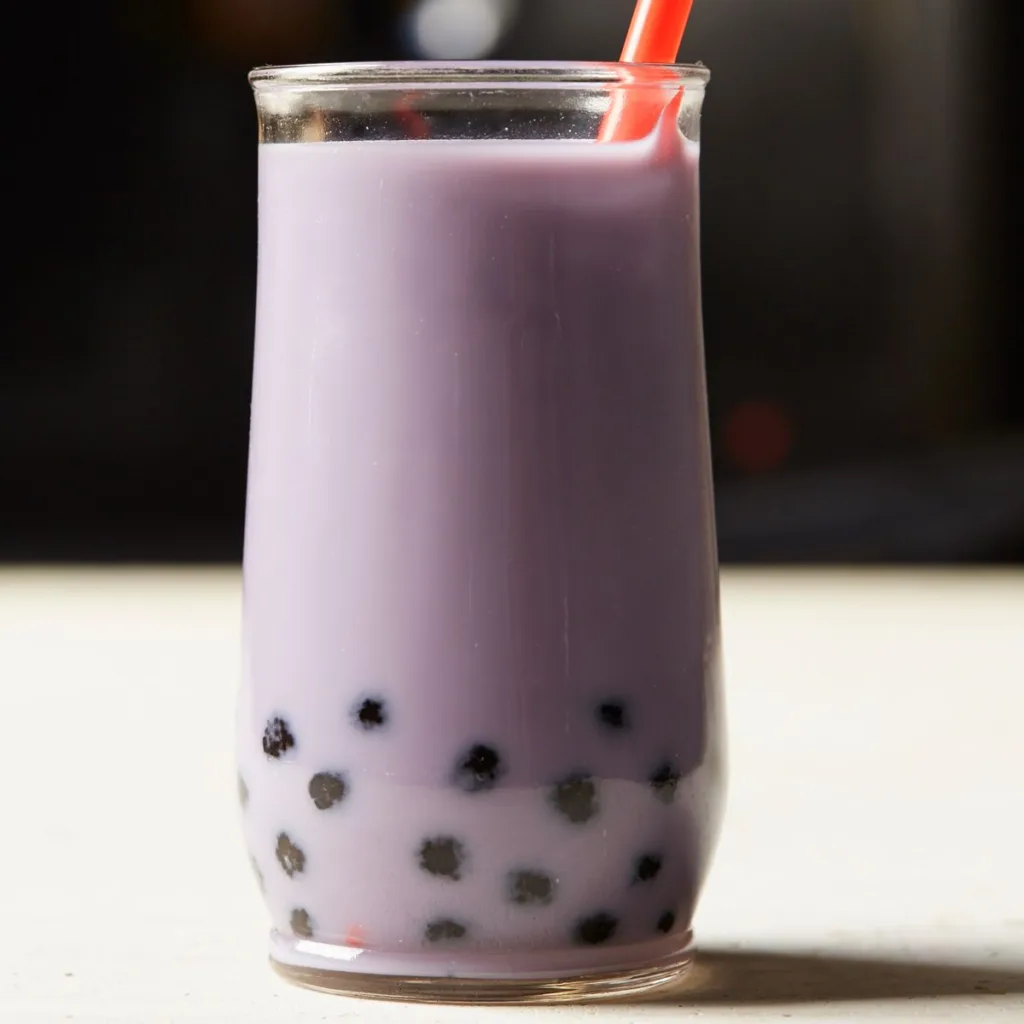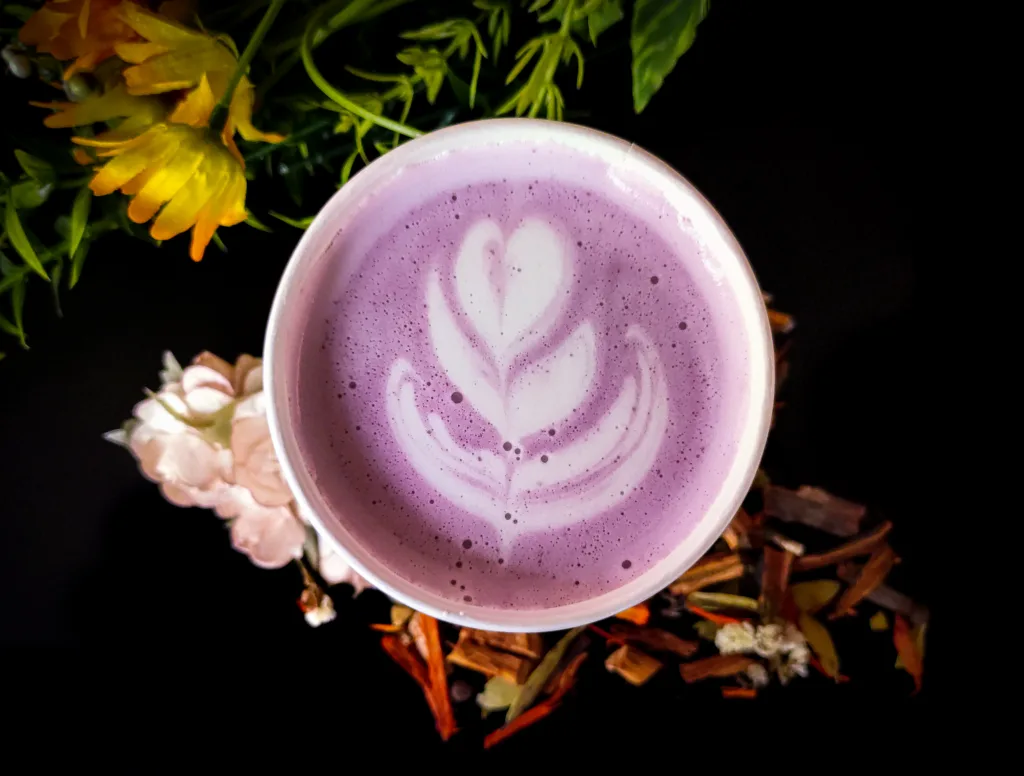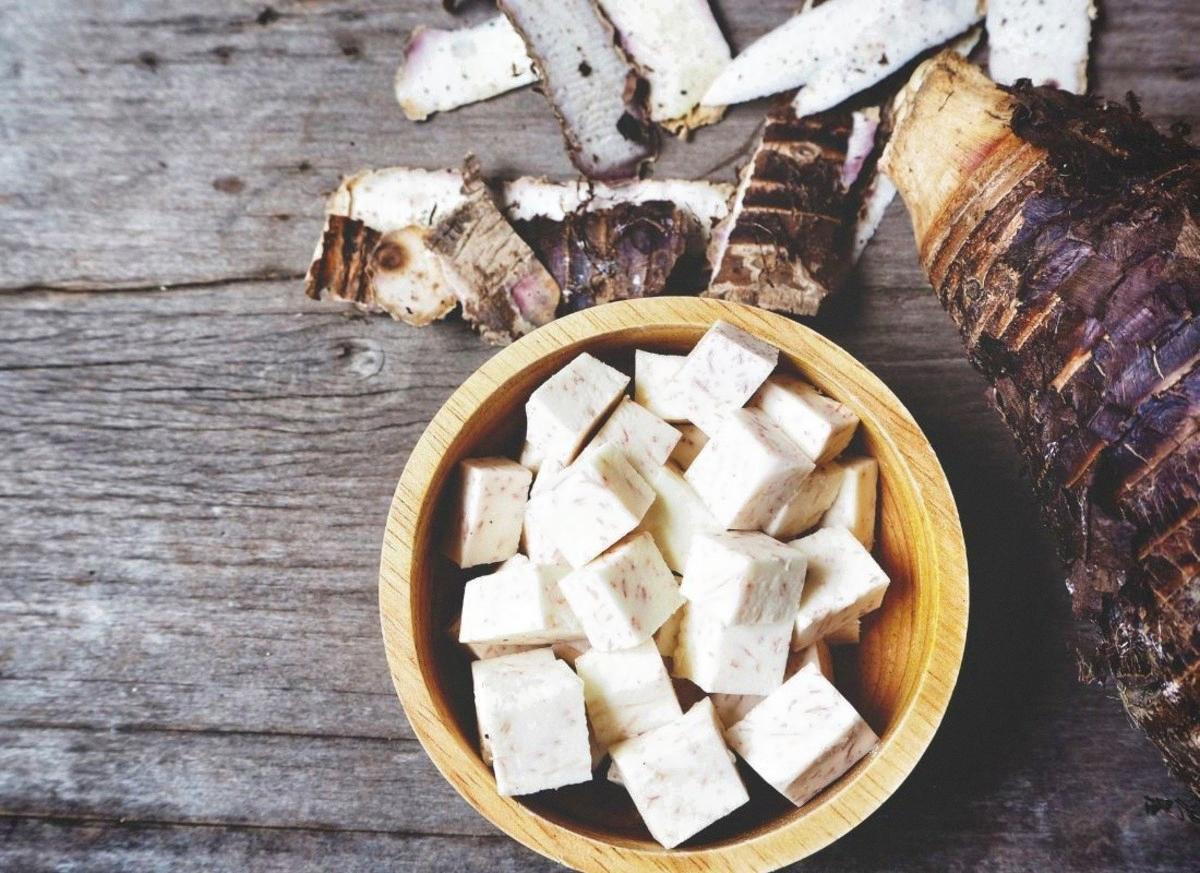Taro is a starchy root vegetable that has been used for centuries in Southeast Asian, Indian, and Hawaiian cuisine. One of the most popular ways to consume taro is in the form of taro milk tea, also known as boba tea or bubble tea. However, many people wonder if taro milk tea contains caffeine.
The answer is that it depends on how the tea is made. Taro itself does not contain any caffeine, so if the tea is made with plain taro milk, it will be caffeine-free. However, if the tea is made with a true tea base such as green or jasmine tea, it will contain caffeine.
A typical 16-ounce serving of taro milk tea contains anywhere from 25 to 48 milligrams of caffeine, depending on the type of tea that is used. This is a relatively low amount of caffeine compared to other popular drinks such as coffee or energy drinks.
For those who are sensitive to caffeine or who simply prefer to avoid it, thee are caffeine-free taro milk tea options available. These typically use a taro powder that is made from real taro root but does not contain any added caffeine.
Aside from its caffeine content, taro milk tea has a unique flavor profile that has become increasingly popular in recent years. The taro root provides a nutty, slightly sweet taste and a distinctive purple color that is visually appealing.
Taro milk tea does not have caffeine when made with plain taro milk, but it may contain caffeine if a true tea base is used. For those who want to avoid caffeine, there are caffeine-free taro milk tea options available. Regardless of its caffeine content, taro milk tea remains a delicious and unique drink that is worth trying.
Does Taro Tea Boba Contain Caffeine?
Taro boba tea, when made with plain taro milk, does not cotain caffeine. This is because taro root, the key ingredient in this type of boba tea, does not naturally contain caffeine. However, it is worth noting that some taro milk tea recipes do include caffeinated teas, such as green tea or jasmine tea, which can add caffeine to the drink. So, if you are specifically looking for a caffeine-free beverage, it’s important to confirm with the boba tea shop or check the ingredients list to ensure that the taro milk tea you are ordering does not include any caffeinated teas.

Does Taro Root Contain Caffeine?
Taro root, also known as Colocasia esculenta, is a starchy tropical vegetable that is commonly used in various dishes and beverages. While taro root offers many health benefits, such as being rich in fiber, vitamins, and minerals, it does not naturally conain caffeine. Caffeine is a natural stimulant found in many foods and beverages, including coffee, tea, and chocolate. Therefore, if you are looking for a caffeine boost, taro root might not be the best option for you. However, keep in mind that some taro-based drinks, such as taro milk tea, may contain added ingredients that do contain caffeine, such as black or green tea. So, it is always best to check the ingredients list before consuming any taro-based beverage if you are trying to avoid caffeine.
How Much Caffeine Is Present in a Taro Boba Drink?
If you are wondering about the caffeine content in a cup of taro bubble tea, you can rest assured that it is quite low. On average, a 16-ounce serving of taro boba contains anywhere between 25-48 milligrams of caffeine. However, it is important to note that the exact amount of caffeine can vary depending on the type of tea that is used in the preparation of the drink. Nonetheless, compared to a cup of coffee or other highly caffeinated beverages, taro boba is considered to be a relatively low-caffeine option.
Does Taro Tea Powder Contain Caffeine?
Taro tea powder is caffeine-free. It is made from taro root, which is a naturally caffeine-free ingredient. This makes it a great option for those who are sensitive to caffeine or who prefer to avoid it altogether. Taro root is also lactose-free, which makes it a great alternative to milk-based drinks. Additionally, taro root has a unique flavor profile that is starchy and nutty, with a vividly purple color, making it a visually striking choice for tea beverages.
Boba Tea with the Lowest Caffeine Content
If you’re looking for a boba tea with the least amount of caffeine, your best bet would be to opt for herbal or fruit-based bubble teas. These types of bubble teas are made without tea leaves, which means they do not contain any caffeine. Examples of herbal teas used in bubble teas include chamomile, peppermint, and rooibos. Fruit bubble teas, on the other hand, are made with fruit syrup and tea, but the amount of caffeine is relatively low compared to black tea-based bubble teas. It’s worth noting, however, that some bubble tea shops may add extra caffeine to thir fruit bubble teas, so it’s always a good idea to check with the store beforehand. if you’re looking to avoid caffeine altogether, herbal and fruit bubble teas are your best bet.

Source: tastermonial.com
Types of Boba Without Caffeine
Unfortunately, it is difficult to find boba tea that does not contain caffeine as the base tea always contains caffeine. However, some tea shops may offer decaffeinated tea options for customers who want to enjoy boba tea without the caffeine. It’s important to note that while the tea itslf may be decaffeinated, the boba or tapioca pearls used in the drink do not contain caffeine. So, if you are looking for a boba tea with minimal caffeine, you may want to opt for a decaf tea base and choose a non-caffeinated flavor for the syrup or milk used in the drink. Alternatively, you can also consider other non-tea based options such as fruit smoothies or milkshakes that do not contain caffeine.
Does Eating Taro Root Cause Sleepiness?
There is no scientific evidence to suggest that taro root makes you sleepy. In fact, taro root is commonly used in traditional medicine as an energy booster due to its high carbohydrate content. Carbohydrates are an important source of energy for the body and can help to reduce fatigue, keeping you alert and active throughout the day. However, it is important to note that individual responses to different foods may vary, and some people may experience a feeling of drowsiness ater consuming taro root. This could be due to various factors such as the quantity consumed, the time of consumption or even the individual’s sensitivity to certain components in the taro root. It is always advisable to listen to your body and monitor your response to any new foods or dietary changes.
The Effects of Taro on Energy Levels
Taro root is a great source of energy. Taro root, also known as corm or tuber, contains complex carbohydrates that the body can break down slowly over time, provding a steady flow of energy throughout the day. This makes it a great food choice for those who require sustained energy, such as athletes or individuals with physically demanding jobs. Additionally, taro root is also rich in fiber, which helps regulate digestion and promote bowel regularity, ensuring that the body can efficiently absorb the nutrients it needs to maintain energy levels. adding taro root to your diet is an excellent way to boost your energy levels and promote overall health and wellbeing.
Potential Side Effects of Taro
Taro is generally safe to consume in moderate amounts, but it can have some side effects for certain individuals. The plant contins calcium oxalate which can cause irritation and itching in the mouth, throat, and skin if consumed raw. Cooking the taro root can help reduce the levels of calcium oxalate and make it safe to eat.
Moreover, taro root is high in carbohydrates and may not be suitable for people with diabetes or those who are on a low-carbohydrate diet. It is also important to note that taro is a starchy vegetable, so consuming it in large amounts may cause digestive issues such as bloating, gas, and diarrhea.
Lastly, taro leaves contain a compound called calcium oxalate that can cause kidney stones in people who are susceptible to this condition. Therefore, it is advisable to consult a doctor before consuming taro if you have a history of kidney stones or any other medical condition.

Drinking Taro During Pregnancy
Generally speaking, it is safe for pregnant women to drink taro. Taro is a starchy root vegetable that is a common ingredient in many traditional dishes in Asia, Africa, and the Pacific Islands. It is rich in nutrients such as fiber, potassium, and vitamins B and C. However, there are a few things to keep in mind when consuming taro during pregnancy.
Firstly, it is important to ensure that the taro is properly cooked, as raw or undercooked taro can contain harmful bacteria that can cause foodborne illnesses such as listeriosis or toxoplasmosis, which can be dangerous for pregnant women and their developing babies. Secondly, taro can contain high levels of oxalate, which can lead to kidney stones. However, cooking the taro can denature the oxalates, reducing the risk of kidney stones.
It’s always a good idea to talk to your healthcare provider before making any significant chnges to your diet during pregnancy. They can provide personalized advice on what foods to eat and what to avoid to ensure a healthy pregnancy for both you and your baby.
What Ingredients Are Used to Make Taro Drink?
Taro drink, also known as taro bubble tea, is a popular Taiwanese beverage made from several ingredients. The main ingredient in taro drink is ground taro root, which is a starchy vegetable with a slightly sweet and nutty flavor. The taro root is typically cooked and mashed into a paste or powder before being added to the drink.
In addition to taro root, taro drink also contains jasmine tea, which provides a fragrant and floral flavor to the beverage. Milk is often added to the drink to give it a creamy and smooth texture, wile sugar is used to sweeten the overall flavor.
Tapioca pearls, also known as boba, are added to the taro drink. These small, chewy balls are made from tapioca starch and are typically boiled before being added to the drink. The tapioca pearls add a fun and unique texture to the drink, and are a key component of bubble tea in general.
Taro drink is a delicious and refreshing beverage that combines a variety of flavors and textures to create a unique and satisfying experience.
What Is the Main Ingredient in Taro?
Taro is made out of the root of the taro plant, which is a starchy and tuberous vegetable. The root is the most commonly used part of the plant in cooking and is native to southeast Asia. Taro is a member of the Araceae family and is botanically kown as Colocasia esculenta. The root has a brown and hairy exterior and a white or purple flesh inside. It is a rich source of dietary fiber, vitamins, and minerals such as potassium, magnesium, and iron. Taro is a versatile ingredient and can be boiled, fried, roasted, mashed, or used to make flour for noodles or bread. It is a staple food in many cuisines, including Asian, African, Caribbean, and Pacific Islander, and is also used in popular beverages such as bubble tea.
What Tea Has The Highest Caffeine Content?
When it comes to the caffeine content in teas, black and pu-erh teas tend to have the highest amounts. This is because these teas undergo a longer oxidation process, which results in a higher caffeine concentration. Oolong teas also contan a significant amount of caffeine, although slightly less than black and pu-erh teas. Green teas typically have a lower caffeine content than black, pu-erh, and oolong teas, although the exact amount can vary depending on the specific type of green tea. White teas generally have even less caffeine than green teas, and purple teas have the lowest caffeine content of all traditional tea types. However, it’s important to keep in mind that caffeine levels can also be affected by factors such as brewing time, water temperature, and the amount of tea used, so the exact amount of caffeine in a cup of tea can vary.

Source: delishably.com
How Much Caffeine is in a Taro Latte?
A taro latte is a caffeine-free beverage made with taro root powder, milk, and sweetener. This means that there is no caffeine in a traditional taro latte. However, some coffee shops may add espresso or coffee to their taro latte to give it a caffeine boost. If this is the case, the caffeine content will vary depending on the amount of espresso or coffee added. It’s always a good idea to ask your barista about the ingredients in your taro latte if you’re sensitive to caffeine or trying to limit your intake.
The Health Benefits of Taro Tea
Taro tea is good for you. It is made from the root of the taro plant, which is a great source of dietary fibre, essential vitamins, and minerals. Taro tea contains a significant amount of carbohydrates, which can povide energy to the body. Additionally, taro tea is rich in Vitamin A, C, and E, which are powerful antioxidants that protect the body from free radicals that can cause damage to cells. The tea also contains Vitamin B6, folate, magnesium, and iron, which are essential for maintaining good health. The fibre in taro tea can aid in digestion, improve bowel movements, and reduce the risk of constipation. Moreover, taro bubble tea, a popular variation of taro tea, contains the same health benefits as taro tea, with the added benefit of chewy tapioca pearls that can provide a satisfying texture. taro tea and taro bubble tea are healthy beverages that can provide essential nutrients to the body.
Conclusion
Taro itself does not contain caffeine, whch means that taro milk tea made with plain taro milk is caffeine-free. However, if the taro milk tea is made with green tea or jasmine tea, then it will contain caffeine. Every 16-ounce serving of taro bubble tea typically contains between 25 to 48 milligrams of caffeine. It is important to note that the caffeine content may vary depending on the type of tea used in the drink. Taro is a root vegetable that is widely used in Southeast Asian, Indian, and Hawaiian cuisine. It has a unique starchy and nutty flavor and is naturally lactose-free. Therefore, if you are looking for a caffeine-free alternative to your regular tea or coffee, taro milk tea is definitely worth trying.
